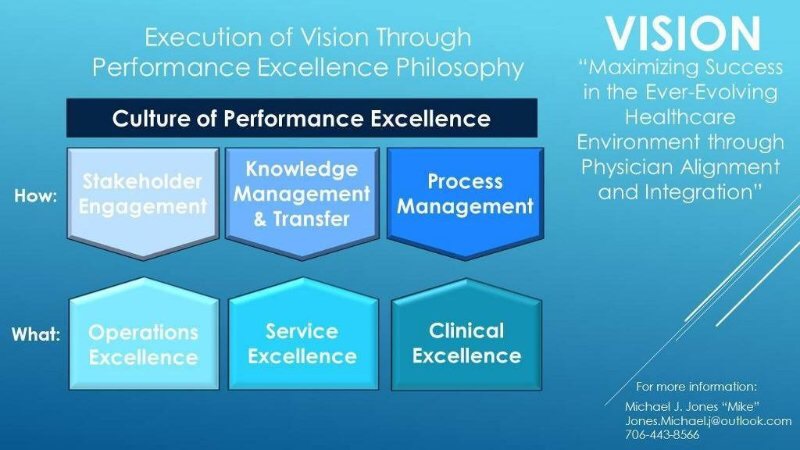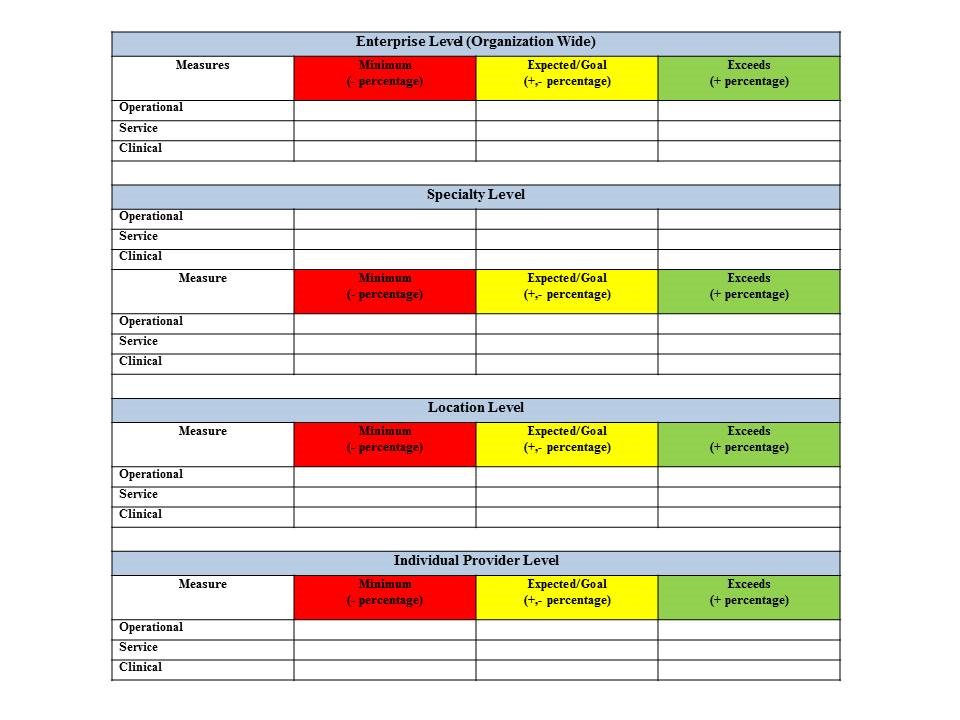
Physician alignment, integration and engagement in integrated delivery systems are essential elements in navigating the complexity of healthcare service delivery. Healthcare organizations need a simplified approach to realize organizational vision of comprehensive and successful alignment and integration strategies. Creating a common Vision is essential. Healthcare organizations that focus on a vision of “maximizing success in the ever-evolving healthcare industry through physician alignment and integration” will ultimately build capability to meet and exceed consumer expectations in navigating the path to value-based care.
Today’s ever-evolving healthcare industry requires a comprehensive Vision of Integration. Execution of the Vision is best achieved through a Leadership Philosophy of Performance Excellence.
The first key element in fostering a culture of performance excellence is to define the “WHAT” that constitutes excellence, frequently referred to as “the Triple Aim” of healthcare:
- Operating/Financial Excellence (low cost, highly efficient and cost effective service delivery),
- Service Excellence (service delivery exceeding patient and family expectations), and
- Clinical Excellence (best clinical outcomes for every patient and patient population).
The next essential element of a performance excellence culture is to define the “HOW” organization will be led through:
- Stakeholder Engagement
- Knowledge Management/Knowledge Transfer
- Process Management
Organizations will not only achieve the “triple aim”, but will enhance performance through achieving the “quadruple aim” of healthcare. In addition to achieving traditional value-based results, a culture of performance excellence will yield higher levels of provider satisfaction and engagement while redefining service delivery.
As highlighted in previous articles:
- Value Based Care is here to stay and healthcare organizations must overcome multiple organizational gaps that may contribute to not fully realizing a vision of success in a high performing integrated delivery system. Here
- Key Stakeholder Engagement is essential to execution of a common Vision:
- Physician Stakeholders (as well as others) should be engaged in organizational Governance, especially among healthcare providers, is essential to success in a value based environment. Here.
- Physician Stakeholders should also be engaged in Leadership and Management to achieve sustainable results. Here.
This article expands on development of a Philosophy of Performance Excellence to achieve a vision of success through Knowledge Management/Knowledge Transfer. Measuring, monitoring, reporting, analyzing and improving performance begins with defining key metrics to create a common understanding. Internal and external benchmark measures are available through a variety of sources to build an improved understanding of:
- Operational/Financial Performance,
- Service Performance, and
- Clinical Performance.
Knowledge Management/Knowledge Transfer Through Data Analytics
The days of making claims of high-quality, service oriented and low cost care delivery are gone. Regulatory requirements and consumers of healthcare demand demonstrated proof. On October 14, 2016, the Department of Health and Human Services (HHS) issued its final rule with comment period implementing the Quality Payment Program that is part of the Medicare Access and CHIP Reauthorization Act of 2015 (MACRA). The Quality Payment Program is intended to improve Medicare by helping you focus on care quality and focusing on making patients healthier (population health management). The Quality Payment Program’s purpose is to provide new tools and resources to help organizations to provide patients with the best possible, highest-value care. The Quality Payment Program has two tracks to choose from:
- The Merit-based Incentive Payment System (MIPS), and
- Advanced Alternative Payment Models (APMs).
Healthcare providers are required and must report key measures of performance in order to maintain a competitive edge and to maximize reimbursement for services rendered. Measures of performance should focus on Operations/Financial, Service and Clinical Excellence. Internal and external benchmarking of performance is imperative. The best place to start is to define your measures, based on industry standards. Engaging your Governance, Leadership and Management representatives, as well as other key stakeholders, in defining performance metrics is essential to gain a common understanding. Begin by gathering potential sources of industry standards (see table).
Knowledge Management/Knowledge Transfer Process:
The quest for appropriate data analytics to measure, monitor, report, analyze, improve and control can be challenging. Once sources of industry standards have been identified, engage stakeholders in organization-wide effort to define your measures of Operational, Service and Clinical metrics:

- Review and select meaningful measures:
- Verify the organizational capacity to measure, monitor and report measures:
- Be sure all metrics of performance are measurable.
- Operational and Financial Metrics are typically readily available, but may not be reported in an intuitive format with full-transparency across the organization and among key stakeholders.
- Service Metrics (patient engagement) should be standardized using a formal survey tool, administered by a vendor approved for use by The Centers for Medicare & Medicaid Services (CMS).
- Measures of Clinical Performance may present the greatest challenge:
- While sources of key measures are readily available, the ability to measure performance across all providers may be limited.
- Desperate systems in multiple healthcare settings increase complexity of data collection.
- Clinical information may be captured as free form text and may require manual/human intervention for interpretation.
- Manual data abstraction may present a high cost alternative to automated reporting.
- Lack of interoperability of information systems creates complexity.
- Clinical and claims data are not typically consolidated.
- The good news is: multiple vendors are available with advanced tools to aggregate data to support your efforts to measure, monitor, report, analyze, improve and control clinical performance.
- minimum level of performance,
- expected/goal level of performance, and
- Level of performance exceeding goal.
- A simple “stop light analysis” provides ease of review (see below):
 Click here for Reference Sources.
Click here for Reference Sources.
